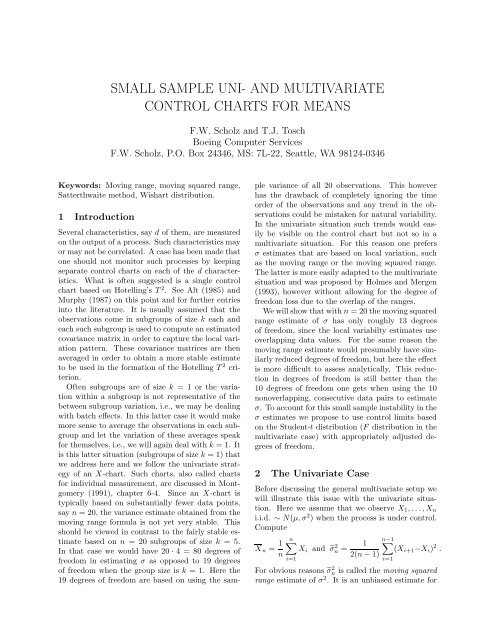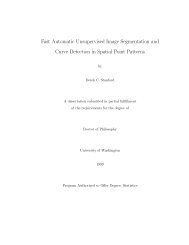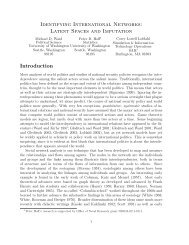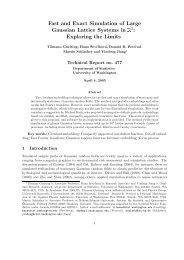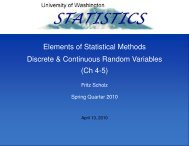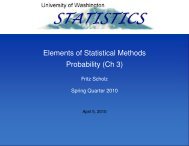small sample uni- and multivariate control charts for means - Statistics
small sample uni- and multivariate control charts for means - Statistics
small sample uni- and multivariate control charts for means - Statistics
Create successful ePaper yourself
Turn your PDF publications into a flip-book with our unique Google optimized e-Paper software.
SMALL SAMPLE UNI- AND MULTIVARIATE<br />
CONTROL CHARTS FOR MEANS<br />
F.W. Scholz <strong>and</strong> T.J. Tosch<br />
Boeing Computer Services<br />
F.W. Scholz, P.O. Box 24346, MS: 7L-22, Seattle, WA 98124-0346<br />
Keywords: Moving range, moving squared range,<br />
Satterthwaite method, Wishart distribution.<br />
1 Introduction<br />
Several characteristics, say d of them, are measured<br />
on the output of a process. Such characteristics may<br />
or may not be correlated. A case has been made that<br />
one should not monitor such processes by keeping<br />
separate <strong>control</strong> <strong>charts</strong> on each of the d characteristics.<br />
What is often suggested is a single <strong>control</strong><br />
chart based on Hotelling’s T 2 . See Alt (1985) <strong>and</strong><br />
Murphy (1987) on this point <strong>and</strong> <strong>for</strong> further entries<br />
into the literature. It is usually assumed that the<br />
observations come in subgroups of size k each <strong>and</strong><br />
each such subgroup is used to compute an estimated<br />
covariance matrix in order to capture the local variation<br />
pattern. These covariance matrices are then<br />
averaged in order to obtain a more stable estimate<br />
to be used in the <strong>for</strong>mation of the Hotelling T 2 criterion.<br />
Often subgroups are of size k = 1 or the variation<br />
within a subgroup is not representative of the<br />
between subgroup variation, i.e., we may be dealing<br />
with batch effects. In this latter case it would make<br />
more sense to average the observations in each subgroup<br />
<strong>and</strong> let the variation of these averages speak<br />
<strong>for</strong> themselves, i.e., we will again deal with k =1. It<br />
is this latter situation (subgroups of size k =1)that<br />
we address here <strong>and</strong> we follow the <strong>uni</strong>variate strategy<br />
of an X-chart. Such <strong>charts</strong>, also called <strong>charts</strong><br />
<strong>for</strong> individual measurement, are discussed in Montgomery<br />
(1991), chapter 6-4. Since an X-chart is<br />
typically based on substantially fewer data points,<br />
say n = 20, the variance estimate obtained from the<br />
moving range <strong>for</strong>mula is not yet very stable. This<br />
should be viewed in contrast to the fairly stable estimate<br />
based on n = 20 subgroups of size k =5.<br />
In that case we would have 20 · 4 = 80 degrees of<br />
freedom in estimating σ as opposed to 19 degrees<br />
of freedom when the group size is k =1. Herethe<br />
19 degrees of freedom are based on using the <strong>sample</strong><br />
variance of all 20 observations. This however<br />
has the drawback of completely ignoring the time<br />
order of the observations <strong>and</strong> any trend in the observations<br />
could be mistaken <strong>for</strong> natural variability.<br />
In the <strong>uni</strong>variate situation such trends would easily<br />
be visible on the <strong>control</strong> chart but not so in a<br />
<strong>multivariate</strong> situation. For this reason one prefers<br />
σ estimates that are based on local variation, such<br />
as the moving range or the moving squared range.<br />
The latter is more easily adapted to the <strong>multivariate</strong><br />
situation <strong>and</strong> was proposed by Holmes <strong>and</strong> Mergen<br />
(1993), however without allowing <strong>for</strong> the degree of<br />
freedom loss due to the overlap of the ranges.<br />
We will show that with n = 20 the moving squared<br />
range estimate of σ has only roughly 13 degrees<br />
of freedom, since the local variabilty estimates use<br />
overlapping data values. For the same reason the<br />
moving range estimate would presumably have similarly<br />
reduced degrees of freedom, but here the effect<br />
is more difficult to assess analytically. This reduction<br />
in degrees of freedom is still better than the<br />
10 degrees of freedom one gets when using the 10<br />
nonoverlapping, consecutive data pairs to estimate<br />
σ. To account <strong>for</strong> this <strong>small</strong> <strong>sample</strong> instability in the<br />
σ estimates we propose to use <strong>control</strong> limits based<br />
on the Student-t distribution (F distribution in the<br />
<strong>multivariate</strong> case) with appropriately adjusted degrees<br />
of freedom.<br />
2 The Univariate Case<br />
Be<strong>for</strong>e discussing the general <strong>multivariate</strong> setup we<br />
will illustrate this issue with the <strong>uni</strong>variate situation.<br />
Here we assume that we observe X 1 ,...,X n<br />
i.i.d. ∼ N(µ, σ 2 ) when the process is under <strong>control</strong>.<br />
Compute<br />
X n = 1 n∑<br />
n−1<br />
X i <strong>and</strong> ˜σ n 2 1 ∑<br />
=<br />
(X i+1 −X i ) 2 .<br />
n<br />
2(n − 1)<br />
i=1<br />
i=1<br />
For obvious reasons ˜σ 2 n is called the moving squared<br />
range estimate of σ 2 . Itisanunbiasedestimate<strong>for</strong>
σ 2 <strong>and</strong> in the Appendix it is shown (as special case<br />
of the <strong>multivariate</strong> case) that f · ˜σ n 2 ≈ σ 2 χ 2 f where<br />
f =2(n − 1) 2 /(3n − 4) are the effective degrees of<br />
freedom which account <strong>for</strong> the overlap. We <strong>for</strong>m<br />
the following T statistic which compares a future<br />
independent observation X with the past history of<br />
the process<br />
√ n X − X n<br />
T =<br />
.<br />
n +1 ˜σ n<br />
Using the fact that X n is independent of ˜σ n 2 we can<br />
approximate the distribution of T by a Student t distribution<br />
with f degrees of freedom when the process<br />
is in <strong>control</strong>. The quality of this approximation is<br />
illustrated in Figure 1. Here N = 1000 <strong>sample</strong>s of<br />
size n =20<strong>and</strong>N = 1000 future observations were<br />
generated from a st<strong>and</strong>ard normal population. X 20<br />
<strong>and</strong> ˜σ 20 were computed <strong>for</strong> each such <strong>sample</strong> <strong>and</strong> the<br />
corresponding T ratio was computed <strong>for</strong> each <strong>sample</strong><br />
<strong>and</strong> its corresponding future observation. The<br />
sorted T ratios are plotted against the corresponding<br />
quantiles of a t distribution with f =12.9 degrees of<br />
freedom. The point pattern follows the main diagonal<br />
exceptionally well <strong>and</strong> thus appears to confirm<br />
the validity of the approximation.<br />
A future observation X is said to be out of <strong>control</strong><br />
when |T | >t f,.99865 ,wherethe.99865 point is<br />
chosen to parallel the pointwise false alarm rate in<br />
the conventional <strong>control</strong> chart based on ±3σ limits.<br />
Using limits based on the t distribution results<br />
in wider <strong>control</strong> limits than would be used in ordinary<br />
X-<strong>charts</strong>. In these latter <strong>charts</strong> one usually<br />
treats the µ <strong>and</strong> σ estimates as though they<br />
agree with the underlying process parameters. This<br />
amounts to setting f = ∞ above. The difference<br />
between this <strong>and</strong> our <strong>small</strong> <strong>sample</strong> treatment is illustrated<br />
in Figure 2a, where the solid <strong>control</strong> limitsarebasedonthet<br />
distribution <strong>and</strong> the dashed<br />
<strong>control</strong> limits are the conventional ones (f = ∞),<br />
i.e., ±3 √ n/(n + 1). In either case the limits are<br />
based on a training <strong>sample</strong> of size n = 20 (the training<br />
<strong>sample</strong> points are not shown here) <strong>and</strong> the long<br />
run behavior <strong>for</strong> N = 1000 future observations is<br />
exhibited. Note that the dashed lines are violated<br />
more frequently than would be desired by the nominal<br />
exception rate of 2.7/1000. In order to point<br />
out another feature we have replicated Figure 2a in<br />
Figure 2b. A comparison of the two figures illustrates<br />
the ”r<strong>and</strong>om effect” of the training <strong>sample</strong>.<br />
Namely, sometimes the training <strong>sample</strong> shows unusually<br />
high dispersion. In that case (Figure 2b)<br />
the T ratios are scaled down too much <strong>and</strong> will be<br />
far away from either set of <strong>control</strong> limits. On the<br />
other h<strong>and</strong>, if the training <strong>sample</strong> shows unusually<br />
low dispersion, then the T ratios will be inflated <strong>and</strong><br />
violate either set of <strong>control</strong> limits more than they<br />
should. This is not illustrated in the interest of saving<br />
space. In any case, the nominal exception rate<br />
of 2.7/1000 should be interpreted as averaged over<br />
all these training <strong>sample</strong> r<strong>and</strong>om effects. If there are<br />
too many exceptions that turn out to be false alarms<br />
one could draw the conclusion that the initial training<br />
<strong>sample</strong> of size n = 20 is not very representative<br />
of the process <strong>and</strong> one should then recalibrate the<br />
limits taking the later data into account. In fact,<br />
such a recalibaration can take place after each new<br />
observation is obtained. This way the price of wider<br />
t-based <strong>control</strong> limits is only temporary. Such an<br />
updated <strong>control</strong> chart is illustrated in Figure 3, using<br />
an initial training <strong>sample</strong> of size n = 20 <strong>and</strong><br />
80 update observations. Strictly speaking, the first<br />
20 points should not have been plotted, since they<br />
do not represent future observation. The narrowing<br />
<strong>control</strong> limits show the updating effect. The dashed<br />
lines also show a very mild updating effect due to the<br />
factor √ n/(n + 1). After some updating (to downplay<br />
the r<strong>and</strong>om effect of the training <strong>sample</strong>) one<br />
may want to stick with the established <strong>control</strong> limits<br />
in order to be more sensitive to slow mean drifts.<br />
3 The Multivariate Case<br />
Here we assume that our observations are vectors<br />
x 1 ,...,x n i.i.d. with d-variate normal distribution<br />
with mean vector µ <strong>and</strong> covariance matrix Σ. We<br />
will <strong>for</strong>m n−1 unbiased estimates of Σ based on local<br />
difference vectors y ν = x ν+1 − x ν , ν =1,...,n− 1,<br />
namely<br />
S ν = 1 2 · y ν · y ν<br />
′<br />
⎛<br />
= 1 2<br />
⎜<br />
⎝<br />
⎞<br />
y ν,1 · y ν,1 y ν,1 · y ν,2 ... y ν,1 · y ν,d<br />
y ν,2 · y ν,1 y ν,2 · y ν,2 ... y ν,2 · y ν,d<br />
⎟<br />
... ... ⎠<br />
y ν,d · y ν,1 y ν,d · y ν,2 ... y ν,d · y ν,d<br />
<strong>and</strong> as pooled estimate <strong>for</strong> Σ use<br />
˜S n =<br />
n−1<br />
1 ∑<br />
(n − 1)<br />
ν=1<br />
S ν =<br />
In the Appendix it is shown that<br />
˜F = f − d +1<br />
f · d<br />
≈ F d,f−d+1 ,<br />
n−1<br />
1 ∑<br />
y ν · y ν ′ 2(n − 1)<br />
.<br />
ν=1<br />
n<br />
n +1 (x − x n) ′˜S−1 n (x − x n )
where<br />
x n = 1 n<br />
n∑<br />
x i , f =<br />
i=1<br />
2(n − 1)2<br />
3n − 4<br />
<strong>and</strong> x is a future observation. The quality of this<br />
F -approximation is illustrated with QQ-plots in Figures<br />
4a-4c. Here the dimension is d =5<strong>and</strong>allcomponents<br />
have common correlation ρ =0,.2,.5. The<br />
<strong>sample</strong> size is n = 20, which results in effective degrees<br />
of freedom of 5 <strong>and</strong> 8.89. As in the <strong>uni</strong>variate<br />
case independent F -ratios were computed, sorted,<br />
<strong>and</strong> compared against corresponding quantiles from<br />
the approximating F -distribution. The approximation<br />
appears to be reasonable <strong>for</strong> various values of<br />
ρ.<br />
This can be used to judge whether a future x is<br />
out of line with the past history of the process by<br />
comparing ˜F with the .9973 point of the F d,f−d+1<br />
distribution. These F -based limits are much wider<br />
than those that would result if one took the estimated<br />
parameters as ”known” true parameters <strong>and</strong><br />
thus applied the appropriate χ 2 d<br />
limits, adjusted by<br />
the factor (f − d +1)n/[fd(n +1)] which appears<br />
in the definition of ˜F . The difference is illustrated<br />
in Figures 5a-5b <strong>for</strong> common correlation ρ = .2. As<br />
in Figures 2a-2b we again observe the r<strong>and</strong>om effect<br />
of the start-up <strong>sample</strong> of size n = 20. The dashed<br />
line is based on the χ 2 5 distribution (modified by the<br />
above factor) <strong>and</strong> leads to many false alarms. This<br />
is much more pronounced here than in the <strong>uni</strong>variate<br />
case, since another 4 degrees of freedom are lost<br />
due to d = 5. Figure 6 is the counterpart to Figure<br />
3 using <strong>multivariate</strong> data with common correlation<br />
ρ = .2. It should be apparent that there is<br />
a much stronger case <strong>for</strong> updating the limits in the<br />
<strong>multivariate</strong> case.<br />
4 Appendix<br />
Let X ′ =(x 1 ,...,x n )bethematrixofn data vectors<br />
in R d ,wherex i ∼ N d (µ, Σ). Let y i = x i+1 −x i<br />
<strong>for</strong> i =1,...,n− 1. In matrix <strong>for</strong>m this can be written<br />
as<br />
⎛<br />
⎜<br />
⎝<br />
−1 1 0 0 ... 0 0<br />
0 −1 1 0 ... 0 0<br />
0 0 −1 1 ... 0 0<br />
... ... ...<br />
0 0 0 0 ... −1 1<br />
⎞ ⎛<br />
⎟<br />
⎠ ⎜<br />
⎝<br />
x ′ 1<br />
x ′ 2<br />
x ′ 3<br />
.<br />
x ′ n<br />
⎞<br />
⎟<br />
⎠<br />
⎛<br />
x ′ 2 − ⎞ ⎛ ⎞<br />
x′ 1<br />
y x ′ 3 − x ′ 1<br />
′ 2<br />
=<br />
x ′ 4 − y ′ 2<br />
x′ 3<br />
=<br />
y ′ 3<br />
⎜<br />
⎟ ⎜ ⎟<br />
⎝ . ⎠ ⎝ . ⎠<br />
x ′ n − x ′ n−1 y n−1<br />
′<br />
or<br />
DX = Y<br />
where D is the above differencing matrix. Consider<br />
next the following unbiased estimate ˜S n of Σ:<br />
˜S n =<br />
1<br />
2(n − 1)<br />
n−1<br />
∑<br />
i=1<br />
y i y ′ i = 1<br />
2(n − 1) Y′ Y<br />
1<br />
=<br />
n − 1 X′ AX ,<br />
where A = D ′ D/2. We will argue that a certain<br />
multiple of ˜S n has a distribution which can be approximated<br />
by a Wishart distribution W d (f,Σ) <strong>for</strong><br />
some f. The idea behind this is basically the same<br />
as the Satterthwaite method of approximating the<br />
distribution of quadratic <strong>for</strong>ms by an appropriate<br />
multiple (α) of a chi-square r<strong>and</strong>om variable with<br />
f degrees of freedom. The multiplier α <strong>and</strong> degree<br />
of freedom f are obtained by matching the first two<br />
moments of the quadratic <strong>for</strong>m <strong>and</strong> the approximating<br />
distribution. That the same can be done in the<br />
<strong>multivariate</strong> case hinges on the following theorem<br />
which may be found in Seber (1984, p.24).<br />
Theorem: Let X ′ = (x 1 ,...,x n ), where x i ∼<br />
N d (0, Σ), <strong>and</strong> let v = Xl, wherel is a d-vector<br />
of constants. Let A be an n × n symmetric matrix<br />
of rank r. Then X ′ AX ∼ W d (r, Σ) if <strong>and</strong> only if<br />
v ′ Av ∼ σ 2 l χ2 r <strong>for</strong> any l ∈ R d ,whereσ 2 l = l′ Σl.<br />
Without loss of generality we assume µ =0when<br />
considering the distribution of ˜S n . Denoting v i =<br />
x ′ i l ∼ N(0,σ2 l )<strong>and</strong>v′ =(v 1 ,...,v n ) we will invoke<br />
the Satterthwaite approximation paradigm, namely,<br />
<strong>for</strong> some α the quadratic <strong>for</strong>m<br />
1<br />
α v′ Av ≈ σl 2 χ 2 f<br />
<strong>for</strong> appropriate α <strong>and</strong> f. First note that<br />
<strong>and</strong><br />
( ) 1<br />
E<br />
α v′ Av<br />
(<br />
= E<br />
( ) 1<br />
var<br />
α v′ Av = 1<br />
1<br />
2α<br />
= n − 1<br />
α<br />
σ2 l<br />
4α 2 n−1<br />
)<br />
n−1<br />
∑<br />
(v i+1 − v i ) 2<br />
i=1<br />
∑<br />
var ( (v i+1 − v i ) 2)<br />
i=1
+ 2<br />
4α 2<br />
∑<br />
1≤i
Figure 2b: Univariate X-Chart<br />
Limits Based on t Approximation<br />
Figure 3: Univariate X-Chart<br />
Limits Based on Updated t Approximation<br />
<strong>control</strong> limits based on training <strong>sample</strong> of 20 observations<br />
initial <strong>control</strong> limits based on training <strong>sample</strong> of 20 observations<br />
t-criterion<br />
-4 -2 0 2 4<br />
t-criterion<br />
-4 -2 0 2 4<br />
N = 1000 future observations<br />
N = 80 future observations with updated <strong>control</strong> limits<br />
0 200 400 600 800 1000<br />
n<br />
0 20 40 60 80 100<br />
n<br />
Figure 4a: QQ-Plot <strong>for</strong> the<br />
F -Approximation<br />
Figure 4b: QQ-Plot <strong>for</strong> the<br />
F -Approximation<br />
observed values<br />
0 2 4 6 8 10 12 14<br />
<strong>sample</strong> size n = 20<br />
denominator degrees of freedom f = 8.89<br />
numerator degrees of freedom = dimension = 5<br />
common correlation rho = 0<br />
•<br />
•• •••• • ••••••••••• • •• •<br />
• • • • •<br />
•<br />
•<br />
N = 1000 simulated F-ratios<br />
observed values<br />
0 2 4 6 8 10 12<br />
<strong>sample</strong> size n = 20<br />
denominator degrees of freedom f = 8.89<br />
numerator degrees of freedom = dimension = 5<br />
common correlation rho = 0.2<br />
• • •••••••• ••• •••••••••• • ••• • • • • • • •<br />
•<br />
•<br />
N = 1000 simulated F-ratios<br />
•<br />
0 2 4 6 8 10 12 14<br />
expected values<br />
0 2 4 6 8 10 12<br />
expected values
Figure 4c: QQ-Plot <strong>for</strong> the<br />
F -Approximation<br />
Figure 5a: Multivariate X-Chart<br />
Limits Based on F Approximation<br />
observed values<br />
0 5 10 15 20<br />
<strong>sample</strong> size n = 20<br />
•<br />
•<br />
•<br />
•<br />
•• ••••••••••••<br />
•<br />
•<br />
•<br />
denominator degrees of freedom f = 8.89<br />
numerator degrees of freedom = dimension = 5<br />
common correlation rho = 0.5<br />
N = 1000 simulated F-ratios<br />
SQRT(F-Ratio)<br />
0.0 0.5 1.0 1.5 2.0 2.5 3.0<br />
limit based on 20 observations<br />
common correlation rho = 0.2<br />
dimension = 5<br />
0 5 10 15 20<br />
expected values<br />
0 200 400 600 800 1000<br />
n<br />
Figure 5b: Multivariate X-Chart<br />
Limits Based on F Approximation<br />
Figure 6: Multivariate X-Chart<br />
Limits Based on Updated F Approximation<br />
SQRT(F-Ratio)<br />
0.0 0.5 1.0 1.5 2.0 2.5 3.0<br />
limit based on 20 observations<br />
common correlation rho = 0.2<br />
dimension = 5<br />
SQRT(F-Ratio)<br />
0 1 2 3 4 5<br />
limit based on 20 observations<br />
dimension = 5<br />
common correlation rho = 0.2<br />
initial <strong>control</strong> limits based on training <strong>sample</strong> of 20 observations<br />
N = 80 future observations with updated <strong>control</strong> limits<br />
0 200 400 600 800 1000<br />
n<br />
0 20 40 60 80 100<br />
n


